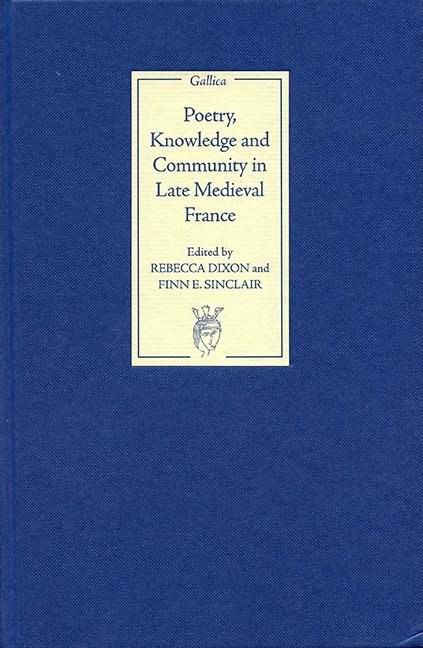Book contents
- Frontmatter
- Contents
- List of Illustrations
- List of Contributors
- Preface
- Introduction: L'Amour de Sophie. Poésie et savoir du Roman de la 1 Rose à Christine de Pizan
- PART I LEARNED POETRY/POETRY AND LEARNING
- Part II Poetry or Prose?
- 5 Les Razos et l'idée de la poésie
- 6 A Master, a Vilain, a Lady and a Scribe: Competing for Authority in a Late Medieval Translation of the Ars amatoria
- 7 Deversifying Knowledge: The Poetic Alphabet of the Prose Pèlerinage de la vie humaine
- 8 Prosifying Lyric Insertions in the Fifteenth-Century Violette (Gérard de Nevers)
- 9 The Movement from Verse to Prose in the Allegories of Christine de Pizan
- Part III Poetic Communities
- Conclusion: Knowing Poetry, Knowing Communities
- Bibliography
- Index
- Miscellaneous Endmatter
9 - The Movement from Verse to Prose in the Allegories of Christine de Pizan
from Part II - Poetry or Prose?
Published online by Cambridge University Press: 25 October 2017
- Frontmatter
- Contents
- List of Illustrations
- List of Contributors
- Preface
- Introduction: L'Amour de Sophie. Poésie et savoir du Roman de la 1 Rose à Christine de Pizan
- PART I LEARNED POETRY/POETRY AND LEARNING
- Part II Poetry or Prose?
- 5 Les Razos et l'idée de la poésie
- 6 A Master, a Vilain, a Lady and a Scribe: Competing for Authority in a Late Medieval Translation of the Ars amatoria
- 7 Deversifying Knowledge: The Poetic Alphabet of the Prose Pèlerinage de la vie humaine
- 8 Prosifying Lyric Insertions in the Fifteenth-Century Violette (Gérard de Nevers)
- 9 The Movement from Verse to Prose in the Allegories of Christine de Pizan
- Part III Poetic Communities
- Conclusion: Knowing Poetry, Knowing Communities
- Bibliography
- Index
- Miscellaneous Endmatter
Summary
Christine de Pizan is remarkable in many ways, not least as an author who produced an extraordinarily large volume of writing in a comparatively short period. Among these works are several allegories, some in verse and some in prose. Readers have tended to interpret Christine's movement from verse to prose allegory as simply a choice motivated by convenience or, somewhat more subtly, as an early manifestation of the complex and ornate prose style that would become ubiquitous in the later fifteenth century. This chapter argues that Christine's movement from verse to prose can fruitfully be understood in two complementary ways. First, it participates in an effort to integrate some of the rational and argumentative structures found in late-fourteenthcentury French translations of philosophical and scientific writings within the originally poetic forms of medieval allegory; and, second, it is in step with Christine's definition of ‘poesie’ as a form of allegorical language that can be expressed through prose as readily as through verse. I have argued elsewhere that Christine's allegory exhibits features that depart from earlier allegorical models, especially with regard to the use of personification. Her novel approach to allegory is perhaps nowhere so fully expressed, however, as with her redefinition of the mode as less a genre than a manner of expression. Christine innovatively constructs a notion of ‘poesie’ that establishes a range of texts – mythographic, historical, even scientific – as the object of allegorical exposition and as the source of hidden knowledge whose acquisition unites the interpretive community of perceptive readers.
Christine's first allegory, the Epistre Othea, combines verse and prose. This combination differs, however, from the prosimetrum form familiar from a number of allegories influential during the Middle Ages, including Boethius's De consolatione Philosophiae and Alain de Lille's De planctu Naturae: unlike these texts, in which the regular alternation of prose and verse reflects the dialogic interaction of narrator and personified interlocutor, the Epistre Othea features a four-part structure in which a short piece of verse is surrounded by an emblematic illustration and two distinct layers of prose commentary. This allegory differs substantially in form from Christine's subsequent works. The later works feature a linear narrative, in which Christine makes a journey or participates in the construction of a city, while the Epistre Othea is static and progress occurs only didactically, in the education of the reader.
- Type
- Chapter
- Information
- Poetry, Knowledge and Community in Late Medieval France , pp. 136 - 148Publisher: Boydell & BrewerPrint publication year: 2008



